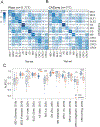Lupus and inflammatory bowel disease share a common set of microbiome features distinct from other autoimmune disorders
- PMID: 39874239
- PMCID: PMC11868722
- DOI: 10.1136/ard-2024-225829
Lupus and inflammatory bowel disease share a common set of microbiome features distinct from other autoimmune disorders
Abstract
Objectives: This study aims to elucidate the microbial signatures associated with autoimmune diseases, particularly systemic lupus erythematosus (SLE) and inflammatory bowel disease (IBD), compared with colorectal cancer (CRC), to identify unique biomarkers and shared microbial mechanisms that could inform specific treatment protocols.
Methods: We analysed metagenomic datasets from patient cohorts with six autoimmune conditions-SLE, IBD, multiple sclerosis, myasthenia gravis, Graves' disease and ankylosing spondylitis-contrasting these with CRC metagenomes to delineate disease-specific microbial profiles. The study focused on identifying predictive biomarkers from species profiles and functional genes, integrating protein-protein interaction analyses to explore effector-like proteins and their targets in key signalling pathways.
Results: Distinct microbial signatures were identified across autoimmune disorders, with notable overlaps between SLE and IBD, suggesting shared microbial underpinnings. Significant predictive biomarkers highlighted the diverse microbial influences across these conditions. Protein-protein interaction analyses revealed interactions targeting glucocorticoid signalling, antigen presentation and interleukin-12 signalling pathways, offering insights into possible common disease mechanisms. Experimental validation confirmed interactions between the host protein glucocorticoid receptor (NR3C1) and specific gut bacteria-derived proteins, which may have therapeutic implications for inflammatory disorders like SLE and IBD.
Conclusions: Our findings underscore the gut microbiome's critical role in autoimmune diseases, offering insights into shared and distinct microbial signatures. The study highlights the potential importance of microbial biomarkers in understanding disease mechanisms and guiding treatment strategies, paving the way for novel therapeutic approaches based on microbial profiles.
Trial registration number: NCT02394964.
Keywords: ankylosing; autoimmune diseases; lupus erythematosus; machine learning; spondylitis; systemic.
Copyright © 2024 The Author(s). Published by Elsevier B.V. All rights reserved.
Conflict of interest statement
Competing interests
M.A.K. received salary, consulting fees, honoraria, or research funds from Eligo Biosciences, Enterome, Novartis, Roche, Genentech, Bristol–Meyers Squibb, Sanofi, and AbbVie, and holds a patent on the use of microbiota manipulations to treat immune-mediated diseases. H.Z. is both a salaried employee and a shareholder of Moderna, Inc.
Figures




Similar articles
-
Metagenome-wide association study revealed disease-specific landscape of the gut microbiome of systemic lupus erythematosus in Japanese.Ann Rheum Dis. 2021 Dec;80(12):1575-1583. doi: 10.1136/annrheumdis-2021-220687. Epub 2021 Aug 23. Ann Rheum Dis. 2021. PMID: 34426398 Free PMC article.
-
Exploring the gut microbiome's role in colorectal cancer: diagnostic and prognostic implications.Front Immunol. 2024 Oct 17;15:1431747. doi: 10.3389/fimmu.2024.1431747. eCollection 2024. Front Immunol. 2024. PMID: 39483461 Free PMC article. Review.
-
The shared circulating diagnostic biomarkers and molecular mechanisms of systemic lupus erythematosus and inflammatory bowel disease.Front Immunol. 2024 May 7;15:1354348. doi: 10.3389/fimmu.2024.1354348. eCollection 2024. Front Immunol. 2024. PMID: 38774864 Free PMC article.
-
Quantitative metagenomics reveals unique gut microbiome biomarkers in ankylosing spondylitis.Genome Biol. 2017 Jul 27;18(1):142. doi: 10.1186/s13059-017-1271-6. Genome Biol. 2017. PMID: 28750650 Free PMC article.
-
Exploring Gut Microbiota in Systemic Lupus Erythematosus: Insights and Biomarker Discovery Potential.Clin Rev Allergy Immunol. 2025 Apr 11;68(1):42. doi: 10.1007/s12016-025-09051-4. Clin Rev Allergy Immunol. 2025. PMID: 40216660 Review.
Cited by
-
The gut-immune axis in primary immune thrombocytopenia (ITP): a paradigm shifts in treatment approaches.Front Immunol. 2025 Jun 12;16:1595977. doi: 10.3389/fimmu.2025.1595977. eCollection 2025. Front Immunol. 2025. PMID: 40574831 Free PMC article. Review.
References
-
- Zhang X, Zhang D, Jia H, Feng Q, Wang D, Liang D, et al. The oral and gut microbiomes are perturbed in rheumatoid arthritis and partly normalized after treatment. Nat Med. 2015. Aug;21(8):895–905. - PubMed
-
- Ruff WE, Greiling TM, Kriegel MA. Host–microbiota interactions in immune-mediated diseases. Nat Rev Microbiol. 2020. Sep;18(9):521–38. - PubMed
-
- Miyauchi E, Shimokawa C, Steimle A, Desai MS, Ohno H. The impact of the gut microbiome on extra-intestinal autoimmune diseases. Nat Rev Immunol. 2023. Jan;23(1):9–23. - PubMed
Publication types
MeSH terms
Substances
Associated data
Grants and funding
LinkOut - more resources
Full Text Sources
Medical
Research Materials

